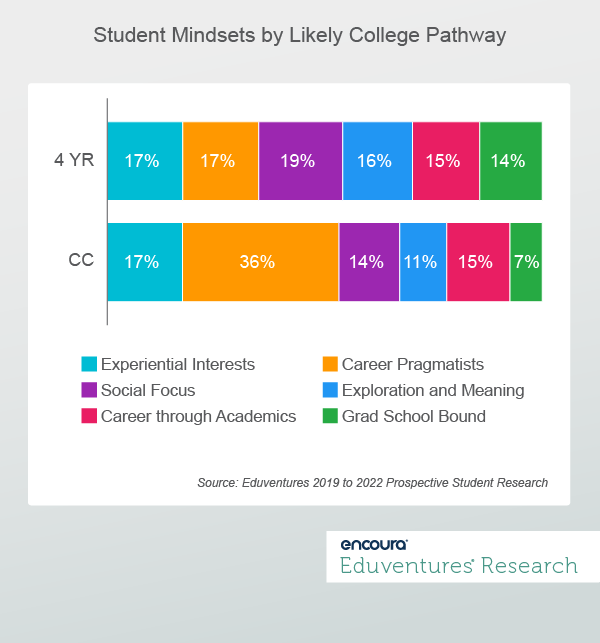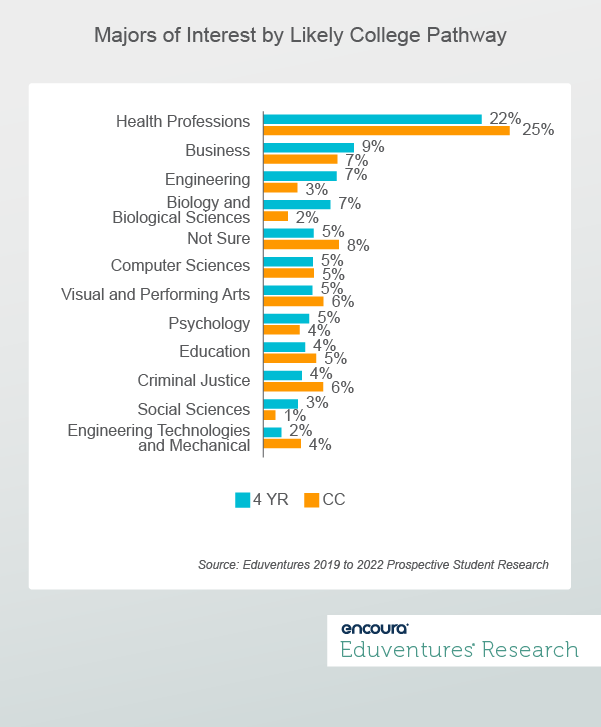June 14-16, 2023
Boston, MA
For many students, attending a four-year college is not a foregone conclusion. While they might have one on their lists, they might also seriously be considering a two-year college or employment as their best postsecondary option.
Nationally, 6% of students on four-year college inquiry lists believe that they are most likely to attend a two-year community or technical college, according to our Prospective Student Research™. It’s not a huge number but understanding these students could make an important incremental difference in enrollment at four-year institutions—either for first-time or transfer enrollment.
Let’s examine the key differences between students who believe they are on a two-year community or technical college pathway versus those who believe they are on a four-year college pathway. Figure 1 shows that students who believe they are likely to attend a community or technical college differ somewhat in their Prospective Student Mindsets™.

As you might expect, many students likely to attend a community or technical college (more than a third) are Career Pragmatists™ focused on finding an affordable education that leads to a job. Many more, however, are not Career Pragmatists – 64% fall into some other Mindset. Seventeen percent are Experiential Interests™ students, 15% are Career through Academics™ students, and 14% are Exploration and Meaning™ students.
The implication of this for community colleges is that there are students in their orbits who want to know about more than the affordable career options. The implication for four-year colleges is that students considering community colleges can fall into almost any Mindset; two-thirds are not stereotypically Career Pragmatists.
When it comes to major interests, we also see that community or technical college students in the four-year inquiry pool are more similar to their peers than different (Figure 2).

Health professions and business are the top two majors regardless of college pathway. Those interested in engineering and biology, however, are considerably more likely to attend a four-year college, while those who are undecided in their major interests skew slightly toward community college.
Where are the real differences, then? Table 1 shows that many key differences come down to demographics.
Demographics of Students by College Pathway
| Four-Year | Community | |
|---|---|---|
| Technical First-generation | 35% | 54% |
| Low Income | 24% | 36% |
| Underrepresented Minority | 36% | 45% |
| A Grades in High School | 74% | 48% |
Table 1.
Students who believe they are likely to attend a community or technical college are more likely to be first-generation college students, to come from low-income families, to be from historically underserved populations, and to have lower high school grades. In fact, a student who has all four of these demographic factors is more than twice as likely as the average student to follow a community college path.
Additionally, nearly half (46%) of likely community college students will have to completely self-finance college (their parents will not make any contributions). By contrast, about a third (34%) of likely four-year college students expect to self-finance.
Students on the community or technical college pathway also expect more flexibility of delivery than their four-year college peers. Only 31% expect to have all courses delivered completely on campus. Many more four-year students (61%) imagine a traditional campus-based education. More flexible delivery options could matter a lot to a student under financial strain—perhaps working multiple jobs to afford college.
Many students on the community or technical college pathway believe they will complete a bachelor’s degree (51%). A little more than a quarter (27%) believe they will complete an associate degree and another fifth (22%) aren’t sure what will happen.
The Bottom Line
Consider the student who has little experience with college, who is not the most confident student, who is facing paying for college with little to no family support. It’s a stretch for this student to consider a four-year school to be a viable option immediately after high school.
For many of these students, community college might just be the right place to start. What can colleges do to work with these students successfully—where the definition of success might be first-time enrollment, but it might also be starting their educations elsewhere before enrolling as a transfer?
To stimulate more first-time enrollment:
- Consider your level of support. Are prospects who are first-generation, low-income, or from underserved backgrounds receiving not only resonant communications, but also the right support in understanding the college decision?
- Build credible affordable pathways. Develop and show how popular majors, like health professions and business, can meet or exceed student expectations for affordability and outcomes.
- Be a part of family conversations about the value of college vs. employment. Students and parents are engaged in conversations about the cost and value of college very early on. This conversation may be about whether college is on the table or off the table for the students at all. Make sure you provide information on this topic throughout the college search.
- Create equitable admissions policies. Examine how your admissions practices help or hurt students who are first-generation, from low-income families, or from underserved populations. Testing policies and financial aid awarding should be aligned with your desires to enroll these students.
To develop your transfer pipeline:
- Inform the decision. Speak candidly with students and parents about their concerns. If the student is a better fit for community college, point them in the right direction. You’ll be remembered for your integrity.
- Build strong institutional relationships. Connect with advisers at sending institutions to foster strong collaboration in helping community college students overcome barriers to four-year enrollment. You will gain an understanding of the counseling efforts at these schools. Strive to be first among recommended four-year transfer institutions.
- Build strong program pathways. Build robust transfer articulation agreements or joint degree programs with your most important feeder community colleges. This will help provide students with clearer academic pathways from two-year to four-year colleges.
- Stay in touch. You’ve built a relationship, now maintain it. Put students that you lose to community colleges into your transfer pipeline. Consider how and when you will communicate with them about their desires to complete a bachelor’s degree. You want to be first on their lists when the time comes.
Never Miss Your Wake-Up Call
Learn more about our team of expert research analysts here.
Eduventures Principal Analyst at Encoura
Contact
This recruitment cycle challenged the creativity of enrollment teams as they were forced to recreate the entire enrollment experience online. The challenge for this spring will be getting proximate to admitted students by replicating new-found practices to increase yield through the summer’s extended enrollment cycle.
By participating in the Eduventures Admitted Student Research, your office will gain actionable insights on:
- Nationwide benchmarks for yield outcomes
- Changes in the decision-making behaviors of incoming freshmen that impact recruiting
- Gaps between how your institution was perceived and your actual institution identity
- Regional and national competitive shifts in the wake of the post-COVID-19 environment
- Competitiveness of your updated financial aid model

